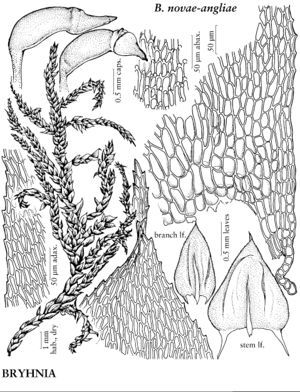Bryhnia novae-angliae
Bull. Torrey Bot. Club 25: 229. 1898.
Plants medium-sized, in moderately loose to dense tufts, light to dark green or yellowish to brownish. Stems to 10 cm, creeping to arching, slightly curved or flexuose, terete- to subcomplanate-foliate, rarely julaceous along some portions of stem, occasionally regularly pinnate, branches to 7 mm, straight to slightly curved, subcomplanate- to complanate-foliate. Stem leaves erect, or patent and twisted to contorted, ovate-triangular to ovate, broadest at 1/7 leaf length or below, not or slightly plicate, longer than broad, 1–1.3(–1.6) × 0.7–1.1 mm; base decurrent; margins serrulate or serrate almost to base; apex acute or gradually to abruptly short-acuminate, rarely cucullate; costa to 60–80% leaf length, strong, terminal abaxial spine present; alar cells short-rectangular, to 30 × 12–16 µm, walls moderately thick, region of many cells, pellucid, not reaching margins, gradually differentiated; laminal cells 20–40 × 4–6 µm, variable on different leaves on same plant, 3–8:1, strongly prorate to prorate-papillose on abaxial surface; basal cells 10–13 µm wide, region in 1 or 2 rows. Seta 1–2 cm. Capsule inclined to horizontal, slightly curved, 1.5–2 mm. Spores 14–18 µm.
Habitat: Soil, rock, rotten logs, wet shady places, forests, along small brooks, wet places on slopes
Elevation: low to high elevations (0-1900 m)
Distribution

N.B., Nfld. and Labr., N.S., Ont., P.E.I., Que., Ala., Ark., Conn., Del., Ga., Ill., Ind., Maine, Md., Mass., Mich., Minn., Mo., N.H., N.J., N.Y., N.C., Ohio, Pa., R.I., Tenn., Vt., Va., W.Va., Wis., Europe.
Discussion
Specimens labeled as Bryhnia novae-angliae from Alaska appear to belong to B. hultenii. Both species are highly variable, so there are morphotypes in both species that have almost identical characters. The common phenotype of B. novae-angliae has its branch leaves rigidly spreading and markedly smaller than stem leaves, but this is not consistent, and sometimes plants are quite similar to Brachythecium rivulare. However, the shorter, usually strongly prorate to prorate-papillose laminal cells indicate Bryhnia. Bryhnia novae-angliae is especially variable near its southern limit; some plants in that region are little branched. Others, as in North Carolina, have blunt leaves resembling Eurhynchiastrum pulchellum; they differ from this species in having flexuose and shorter laminal cells and larger plant size.
Selected References
None.
